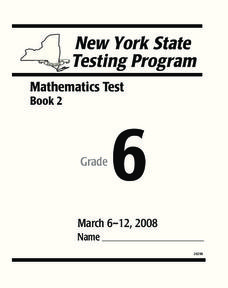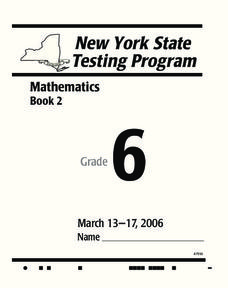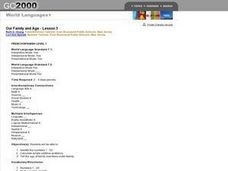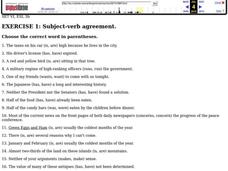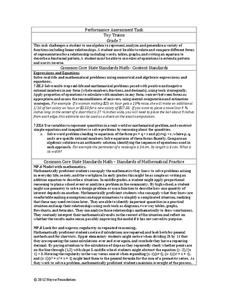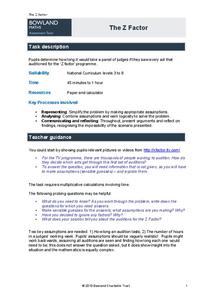Curated OER
Midwest Hospitality
Students create snowflakes using the ideas of symmetry, perpendicularity, and regularity in this Art instructional activity that incorporates Mathematical concepts and artistic design. The instructional activity includes a materials...
Curated OER
Evaluating Expressions Using Tiles
Sixth graders are shown a variety of algebraic equations. In groups, they use tiles to represent each expression in the equations. To end the lesson, they solve story problems with one and two unknown variables. Individuals share their...
Curated OER
Dancing Number Sentences
Learners explore how dance can be infused with mathematics. In this art and mathematics lesson, students recognize how the ABA dance form is similar to a math number sentence. Learners create a dance choosing dance words to represent...
Curated OER
Developing the Concept: Rates
Learners discover how to use the knowledge of unit rates to understand equivalent ratios and solve real-world problems. They are given word problems to solve using equivalent ratios. Tables are also covered in this resource.
Curated OER
New York State Testing Program-Grade 6
In this sixth grade mathematics worksheet, 6th graders assess their knowledge and understanding of the mathematics of sixth grade. The sixteen page worksheet contains ten constructed response questions. Solutions are not...
Curated OER
New York State Testing Program-Grade 6
In this sixth grade mathematics worksheet, 6th graders evaluate their knowledge of grade level mathematics expectations. The sixteen page worksheet contains ten problems, several of which are multi-tiered assessment. Answers...
Curated OER
Our Family and Age
Start by playing a song about numbers. "Sing, Dance, Laugh, and Eat Quiche" is suggested. Then, start counting things around the room. Introduce yourself, and have kids start to introduce themselves when they catch on to the vocabulary....
Curated OER
Math Mouth!
Students examine and discuss math vocabulary. They participate in various games involving the math vocabulary. Use this as a supplement.
Curated OER
Thousands
In this mathematical thousands worksheet, students place five sets of numbers in order from the smallest to the largest. Students pick out certain amounts of numbers in hundreds and thousands.
Curated OER
1-800-MATHFUN
Students complete a number and letter recognition activity by creating phone numbers for businesses. In this telephone number lesson, students brainstorm telephone numbers that include words. Students translate numbers to their numeric...
Curated OER
Functions and Graphing
Graphing functions in a real world application makes math come to life. Learners graph points on a coordinate plane and identify various points on a graph by working through a set of real world problems. This is a perfect review exercise.
Curated OER
Balance Adding Integers
In this positive and negative numbers worksheet, students complete a balance sheet by writing positive and negative numbers in the space to match transactions. They find the balance of the account. This one-page worksheet...
Curated OER
Exercise 1: Subject-verb Agreement
In this grammar worksheet, students choose the appropriate verb in parentheses in twenty-eight sentences that makes each grammatically correct.
Curated OER
Just the Facts! Exploring Order of Operations and Properties of Real Numbers
Sixth graders explore the concept of order of operations. In this order of operations lesson, 6th graders view a powerpoint about order of operations in society. Students post on a blog about order of operations.
Noyce Foundation
Truffles
Knowing how to scale a recipe is an important skill. Young mathematicians determine the amount of ingredients they need to make a certain number of truffles when given a recipe. They determine a relationship between ingredients given a...
Noyce Foundation
Toy Trains
Scholars identify and continue the numerical pattern for the number of wheels on a train. Using the established pattern and its inverse, they determine whether a number of wheels is possible. Pupils finish...
Noyce Foundation
Building Blocks
Building blocks have more uses than simply entertaining children. Young mathematicians calculate the volume of a given cube, and then calculate the volume and surface area of a prism formed from multiple cubes.
Education Development Center
Integer Combinations—Postage Stamps Problem (MS Version)
Number patterns can seem mysterious. Help your learners unravel these mysteries as they complete an intriguing task. Through examination, collaborative groups determine that they are able to produce all integers above a certain...
Education Development Center
Making Sense of Unusual Results
Collaboration is the key for this equation-solving lesson. Learners solve a multi-step linear equation that requires using the distributive property. Within collaborative groups, scholars discuss multiple methods and troubleshoot mistakes.
Bowland
Design the Mascot
Explore how resizing an object affects its area. The set of lessons challenges young mathematicians to design a mascot for electronic devices. These designs undergo resizing to determine how scale factors of dilation affect area.
Institute of Electrical and Electronics Engineers
Public Keys, One Way Functions and Hard Problems
Use paint to teach about cryptography. Scholars explore public key cryptography by attempting to mix a secret color using paint. After the activity, they investigate the Diffie-Hellman method using prime numbers, exponents, and modular...
Illustrative Mathematics
Games at Recess
A great non-calculation problem that lets your math minds explore without the pressure of the right answer. Your learners will have to compare boys and girls playing soccer and jump rope during recess. How many more boys than girls are...
Illustrative Mathematics
Running to School, Variation 2
Rose's commute to school is a fractional distance. After she runs part of the way, your class needs to determine what fractional distance she ran. This problem explores fraction operations through modeling and computation. The...
Bowland
The Z Factor
Young mathematicians determine the number of hours it would take judges of the "Z Factor" television talent show to watch every act. Participants make estimates and assumptions to solve the problem.




